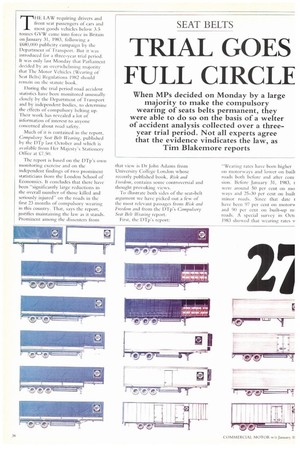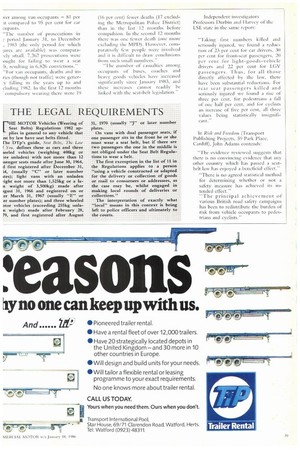TRIAL GOES FULL CIRCLE
Page 38

Page 39

If you've noticed an error in this article please click here to report it so we can fix it.
When MPs decided on Monday by a large majority to make the compulsory wearing of seats belts permanent, they were able to do so on the basis of a welter of accident analysis collected over a threeyear trial period. Not all experts agree that the evidence vindicates the law, as Tim Blakemore reports THE LAW requiring drivers and front seat passengers of cars and most goods vehicles below 3.5 tonnes GVW came into force in Britain on January 31, 1983, following a 5:680,000 publicity campaign by the Department of Transport. But it was introduced for a three-year trial period. It was only last Monday that Parliament decided by an overwhelming majority that The Motor Vehicles (Wearing of Seat Belts) Regulations 1982 should remain on the statute book.
During the trial period road accident statistics have been monitored unusually closely by the Department of Transport and by independent bodies, to determine the effects of compulsory belting up. Their work has revealed a lot of information of interest to anyone concerned about road safety.
Much of it is contained in the report, Compulsory Seat Belt Wearing, published by the DTp last October and which is available from Her Majesty's Stationery Office at 527.50.
The report is based on the DTp's own monitoring exercise and on the independent findings of two prominent statisticians from the London School of Economics. It concludes that there have been "significantly large reductions in the overall number of those killed and seriously injured" on the roads in the first 23 months of compulsory wearing in this country. That, says the report, justifies maintaining the law as it stands. Prominent among the dissenters from
that view is Dr John Adams from University College London whose recently published book, Risk and Freedom, contains some controversial and thought provoking views.
To illustrate both sides of the seat-belt argument we have picked out a few of the most relevant passages from Risk and Freedom and from the DTp's Compulsory Seat Belt Wearing report.
First, the DTp's report: "Wearing rates have been higher on motorways and lower on buili roads both before and after corn sion. Before January 31, 1983, t were around 50 per cent on mo ways and 25-30 per cent on built minor roads. Since that date I have been 97 per cent on motor and 90 per cent on built-up m: roads. A special survey in OCR 1983 showed that wearing rates v ver among van occupants — 81 per it compared to 95 per cent for car cupants.
"The number of prosecutions in
period January 31, to December , 1983 (the only period for which ;tires are available) was compara,ely small. 7,262 prosecutions were ought for failing to wear a seat It, resulting in 6,826 convictions." -For van occupants, deaths and inries (though not traffic) were genery falling in the years up to and chiding 1982. In the first 12 months 'compulsory wearing there were 19 (16 per cent) fewer deaths (17 excluding the Metropolitan Police District) than in the last 12 months before compulsion. In the second 12 months there Wati one fewer death (one more excluding the MPD). However, comparatively few people were involved and it is difficult to draw conclusions from such small numbers."
-The Junnber of casualties among occupants of buses, coaches and heavy goods vehicles have increased significantly since January 1983, and these increases cannot readily be linked with the seat-belt legislation."
Independent investigators Professors Durbin and I larvey of the LSE state in the same report: "Taking first numbers killed and seriously injured, we found a reduction of 23 per cent for car drivers, 311 per cent for front-seat passengers, 20 per cent for light-goods-vehicle drivers and 22 per cent for WV passengers. Thus, for all those directly affected by the law, there have been substantial reductions. For rear scar passengers killed and seriously injured we found a rise of three per cent, for pedestrians a fall of one half per cent, and fir cyclists an increase of five per cent, all three values being statistically insignificant."
In Risk and Freedom (Transport Publishing Projects, 59 Park Place, Cardiff), John Adams contends:
"The evidence reviewed suggests that there is no convincing evidence that any other country which has passed a seat belt law has enjoyed a beneficial effect." "There is no agreed statistical method for determining whether or not a safety measure has achieved its intended effect."
"The principal achievement of various British road safety campaigns has been to redistribute the burden of risk from vehicle occupants to pedestrians and cyclists."






















































